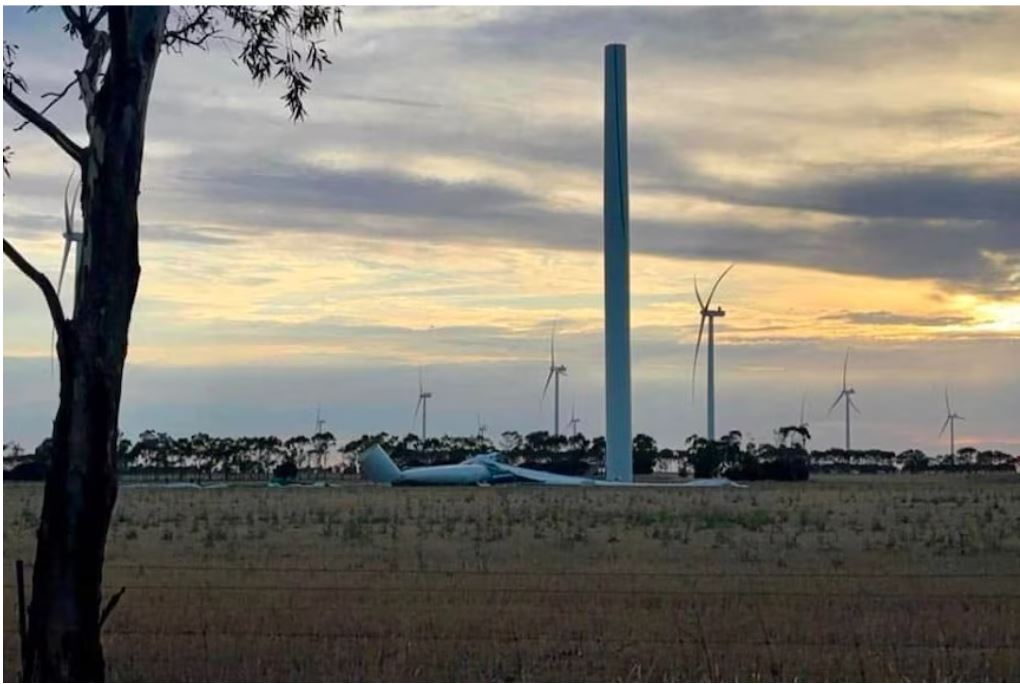
by Jane McNaughton, courtesy of ABC News

A structural engineer says a wind turbine that collapsed in western Victoria should have been able to sustain strong winds.
Photos from the scene show the blades of a wind turbine at the Berrybank Wind Farm, west of Geelong, collapsed in a heap on the ground on Tuesday morning.
Associate Professor of structural engineering at Monash University Amin Heidarpour said the failure was likely in the blades.
“It is totally unacceptable to see a two-year-old wind turbine collapse,” he said.
“The normal service for blades is designed to be 20 years, so two years is very short.”
Life expectancy of turbines
The government said a section of the wind turbine detached in the early hours of Tuesday morning after parts of the state were battered by thunderstorms and damaging winds of 60–70 kilometres per hour.
The expected service life for an entire wind turbine was 30 years, Dr Heidarpour said, but other elements of the infrastructure may need to be replaced earlier.
“While foundations and the main towers are expected to meet this timeline, blades, gearboxes, generators and other smaller hardware may need to be repaired or replaced more frequently,” he said.
“The wind turbine has a foundation at the bottom, the vertical tower, and on top of this tower, we have the blades, and it seems that the failure has occurred at the blades [from seeing the images online].”

Dr Heidarpour said Australian wind farm infrastructure was meant to be built to withstand winds of at least 108kph.
“In this standard, it depends on the location of the structure, and the magnitude of the wind speed changes,” he said.
“But 70kph does not meet this threshold.”
The ABC has contacted Global Power Generation (GPG), which owns the wind farm and is a subsidiary of Spanish company Naturgy.
The company previously told the ABC the project’s remaining wind turbines had been temporarily paused and the site was safely secured.
“An investigation is underway to confirm the root cause of the incident,” a Naturgy spokesperson said.
Danish-company Vestas supplied and installed the turbines and continues to maintain them for GPG.
Very uncommon collapse
Clean Energy Council spokesperson Nicholas Aberle told ABC Mornings the safety of people working in renewables was paramount to the industry.
“Thankfully, we can confirm there were no injuries or fatalities from this incident,” he said.
“There already is a very comprehensive framework for looking at this. WorkSafe and Energy Safe Victoria work extensively with industry to ensure compliance with a range of different standards.”

Incidents like this were “very” uncommon as wind turbines were designed to last for decades, Dr Aberle said.
Dr Aberle said he wanted to see the results of the investigation.
“But in one of the reports I saw yesterday, it indicated this could have been a major lightning strike,” he said.
“What we really need to understand from the investigation is whether this had factors that could have been prevented, in which case everybody needs to learn from that.
“Maybe this turbine was just pretty unlucky and got hit by the mother of all lightning strikes — at this stage, we just don’t know.
“Occasionally things do go wrong … but this is relatively rare and everyone involved is working their hardest to ensure this happens even less frequently.”

Calls for state-wide audit
However, Dr Heidarpour said calls by the Victorian opposition for a safety audit of the state’s wind farms may be unjustified, pending ongoing investigations.
“Wind farms have been operating in Victoria for more than 20 years, and there are now around 41 farms and 2,500 wind turbines in the state,” he said.
“A feasible and optimum approach [needs to be looked at] to assess these turbines.
“I think before saying whether all wind turbines need to be assessed or not, we need to first find the reason behind this recent failure, and then based on that, we should be able to decide if all turbines need to be investigated or not.”